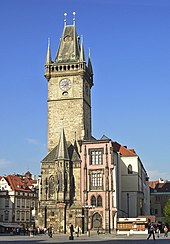Old Town Hall (Prague)
The Old Town Hall ( Staroměstská radnice in Czech ) is located on the southwest corner of the Old Town Square in Prague .
History and architecture
In 1338 King John of Bohemia allowed the citizens of Prague's old town to build a town hall , which they financed from the wine tax . The almost 70 meter high tower was completed in 1364 and extended and rebuilt until the 19th century. After 1360, the town hall was enlarged by a second house on the west side, in which the conference room was located. The famous Prague builder Peter Parler built the town hall chapel in the tower, which was inaugurated in 1381. The town hall clock went into operation in 1410 .
On June 21, 1621, 27 leaders of the Bohemian uprising were publicly executed in front of the town hall . Today, 27 crosses in the pavement commemorate her. In 1784 the town hall became the administrative seat of the united city of Prague, which until then consisted of four independent cities.
In the years 1838 to 1848 the Viennese architects Peter Nobile and Paul Sprenger built a new eastern wing in neo-Gothic style. The entire town hall building was badly damaged during the Prague uprising in May 1945. The military uprising of the Czech resistance against the German occupiers began on May 5, 1945 after a call for an uprising on the Czech radio. Then the fighting of the Czech resistance fighters began around the town hall at around 12.30 p.m. A short time later, German tanks penetrated the Old Town Square and began shooting at the town hall. The mutual shelling lasted until the next day. On May 7th and 8th, tank units of the SS units were relocated to Prague, which until then had been stationed on military training areas south of the city. In addition, other German units invaded Prague from the northeast and killed numerous people. On May 7th, the town hall caught fire for the first time during the bombardment, but the insurgents managed to put the fire out for the time being. On May 8, 1945, the resistance fighters were able to hold the town hall until the afternoon, but then had to leave it because German riflemen set the building on fire again. At the same time, at 4 p.m., the declaration of surrender by the German troops was signed in Prague on Bartolomějská Street. However, the battle for the Old Town Hall was not ended until around 5 p.m. - about an hour after the official declaration of the armistice. The fire in the neo-Gothic wing of the Old Town Hall was brought under control the next day.
The original City Hall building, which was badly damaged during the Prague Uprising, was extensively restored after the Second World War . Six axes were broken off from the burnt out seven-axis neo-Gothic extension. In its place there is now a small park with a memorial for those who fell in the uprising.
The building has not served as a town hall since 1945. The city administration moved to the New Town Hall . The historical rooms are open to visitors today. The tower has been accessible by elevator since 2000. Between 2017 and 2018, the town hall and the town hall clock were again extensively renovated.
architecture

The bay window with a 5/8 end is remarkable , which belongs to the Gothic bay chapel, which was started around 1360 and consecrated to the Virgin Mary . While the tracery of the arched gussets and the wimperg (ornamental gable ) crowned with crabs (creeping flowers) are still largely original, the column figures under the canopies are an ingredient of the 19th century. Only the statue of the Virgin Mary on the left corner of the building is a copy of a sandstone figure created in 1381. The original, called the Old Town Madonna, is in the Prague Capital Museum .
The building complex contains several historical halls. The oldest, the old council chamber, in which the city council and the city court met, dates from the 15th century. In addition to valuable historical furniture, there is a richly painted coffered ceiling from the Renaissance period and a baroque room stove. The largest hall is the so-called Brožík Hall, designed in 1910 by the architect Josef Chochol. It is named after the large-format pictures by the history painter Václav Brožík .
A Romanesque- Gothic cellar complex is located under the town hall .
Town hall clock
The Orloj , an astronomical clock, is located at the town hall . The clockwork was built in 1410 by the clockmaker Mikuláš z Kadaně according to the plans of Jan Šindel .
Web links
- Old Town Hall Prague City Tourist Information Office
Individual proof
- ^ Report by Radio Prague from May 4, 2020; https://www.radio.cz/de/rubrik/tagesecho/prager-aufstand-1945-kampf-ums-altstaedter-rathaus , accessed on May 24, 2020.
Coordinates: 50 ° 5 ′ 13.6 ″ N , 14 ° 25 ′ 14.5 ″ E



